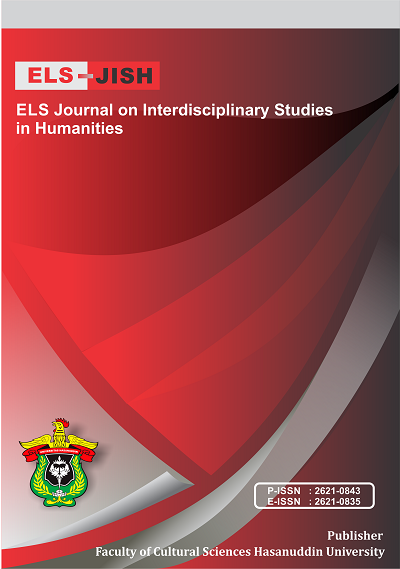Self-Actualization of The Main Character Gadis: a Case Study at Liye’s Novel Sesuk
DOI:
https://doi.org/10.34050/elsjish.v6i2.27290Keywords:
Characters, Characterizations, Novel Sesuk by Tere Liye, elf-ActualizationAbstract
A literary work is seen not only as a work of art that is expressed through various experiences in social life, but also as a creative work related to psychological symptoms, namely human attitudes and behavior. The purpose of this study is to describe the characteristics of the main character, to describe the form of fulfillment of needs as the main character's self-actualization process, and to describe the self-actualization characteristics contained in the main character. This study uses Abraham Maslow's theory of humanistic psychology. The research method used is descriptive qualitative method. The data were obtained from the text in the novel Sesuk by Tere Liye, data from literature studies using heuristic reading techniques. Data analysis was performed by using hermeneutic reading techniques. The results of the study show that Gadis as the main character has both good and bad characters. Fulfilling the physiological needs of the female character, namely eating, drinking, and resting. The fulfillment of the need for security is shown by other characters who look after the girl so that she feels safe. The need for love and belonging is demonstrated by the girl character getting love from the people around her. The need for self-esteem and appreciation is shown by those who try to maintain their self-esteem and parents and people around them who give awards in the form of appreciation to them. The need for actualization is shown through the return of the girl's family to become a complete and harmonious family.
References
Andini, C. (2017). Children Emotion in The Movie "Big Hero 6". (Doctoral dissertation, Universitas Islam Negeri Alauddin Makassar).
Arniati, F., Darwis, M., Rahman, N., & Rahman, F. (2019). Mother Behavior to Their Daughters As Seen in''Pride and Prejudice" and" Little Women". ELS Journal on Interdisciplinary Studies in Humanities, 2(4), 620-625.
Azis, W.N., Rahman, F., & Pattu, A.M. (2022).Intersectionality in Audre Lorde's A Woman Speaks and Coal: A Case Study in Structural-Hermeneutic Approach. IAR Journal of Humanities and Cultural Studies, 12(6), 1107-1113.
Fairuz, Rahman, F., & Amin, M. A. (2022). Authors’ Figurative Expressions From Two Novels: A Comparative Analysis Between RTJNA Rosso and RTJNA Blu. Theory and Practice in Language Studies, 12(1), 150-157.
Hidayat, Y. S. (2022). The Main Character's Self-Actualization in Tere Liye's Novel “Hujan”. General Soedirman University.
Jumiati, Rahman, F., & Lewa, I. (2021). The Potential of Children’s Literature in Educatioan and Environmental Ethics: Linguistic and Literary Approaches. Advances in Social Science, Education and Humanities Research, volume 584 Proceedings of the 1st International Conference on Research in Social Sciences and Humanities (ICORSH 2020). 10.2991/assehr.k.211102.144
Junaid, S., Ahmad, Nurhidayah, Mujizat, A., & Andini, C. (2023). The Quality of Human and Non-Human Relation in Indonesia and England Portrayed in the Selected Picture Books. ELS Journal on Interdisciplinary Studies in Humanities, 6(2), 211-218
Luthfu, M., Sosrohadi S (2022)The Inner Conflict of the Main Characters in the Novel Conspiration of the Universe by Fiersa Besari: A Review of Literature Psychology. https://www.ijassjournal.com/2022/V5I6/414665753.pdf
Milawasri, F. A. (2017). KARYA S.N. RATMANA. Bindo Journal Analysis of the Character of the Main Female Character in the Short Story of the Late Literature, 1(2). https://doi.org/10.32502/jbs.v1i2.740
Nahdhiyah, Rahman, F., Abas, H., & Pattu, M. A. (2023). Ecocritical study on relationships between humans, nature, and god in the novel the Alchemist. Cogent Arts & Humanities, 10(1), 2170019. 10:1, DOI: 10.1080/23311983.2023.2170019
Nurgiyantoro, B. (2013). Fictional Study Theory (Nurgiyantoro Burhan, Ed.). Gajah Mada University Press.
Rahman, F. (2010). Children's literature at a crossroads. Journal of Culture Lens, 5(1), 26-35.
Rahman, F. (2022). The function of Literature dulce et utile in Maintaining National Character. https://doi.org/10.31219/osf.io/u6jtf
Setyowati Susi dan Supriyanto Teguh. (2017). The Process of Self-Actualization of the Main Characters in the Dwilogy of Novel Padang Bulan and Cinta in the Glass. Seloka: Journal of Indonesian Language and Literature Education, 6(1).
Sosrohadi, S., & Wulandari, D. (2022). Character Discrimination Analysis in the Novel Maryam by Okky Madasari. ELS Journal on Interdisciplinary Studies in Humanities, 5(2), 187-197.
Sugiyono. (2019). Qualitative Quantitative Research Methods. Title. In ALFABETA.
Umroh, H. (2018). Women and Actualization. Takammul: Journal of Gender and Islamic Studies and Child Protection, 7(1).
Wahyuningtias, F. (2022). Perceptions of Tabligh Congregation on Self-Actualization for Women in Payaman Village, Secang District, Magelang Regency. Salatiga State Islamic Institute.
Downloads
Published
How to Cite
Issue
Section
License
Copyright (c) 2023 Disza Aulia Haryanto, Somadi Sosrohadi, Sukirno

This work is licensed under a Creative Commons Attribution-ShareAlike 4.0 International License.






